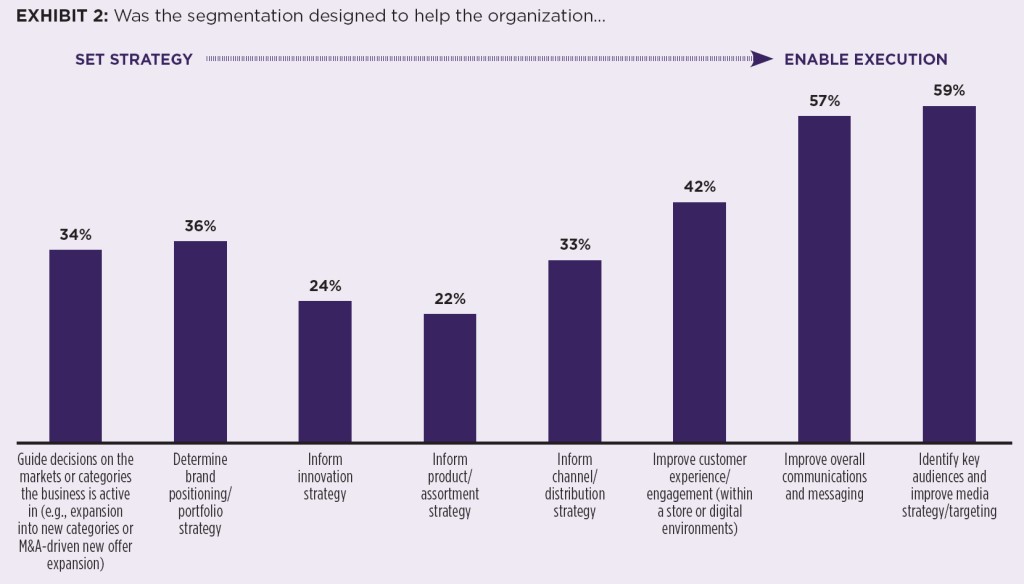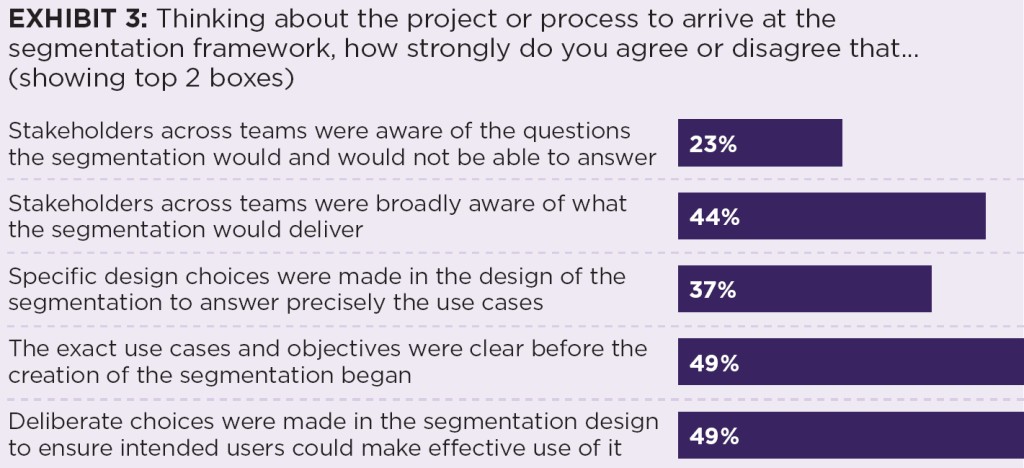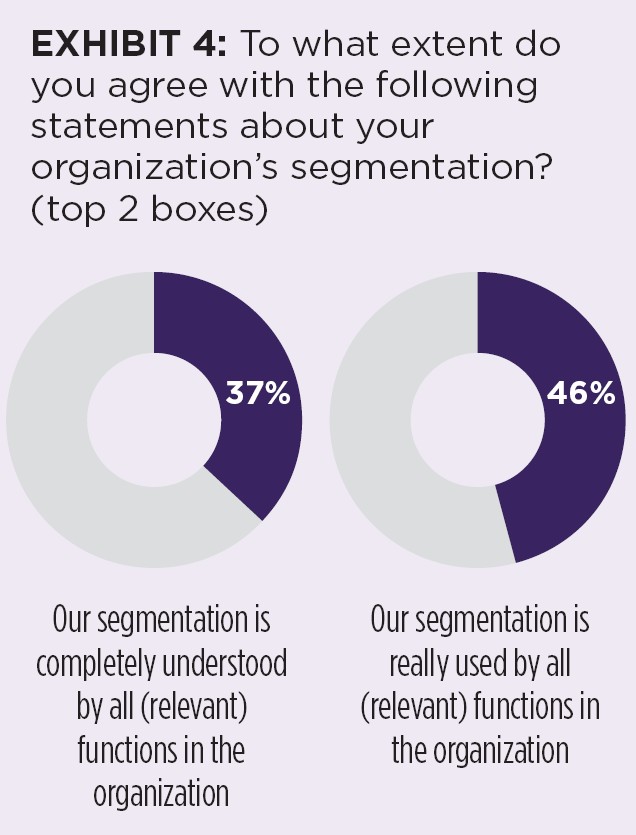Findings from surveys of marketers and their respective organizations by the American Marketing Association (AMA) and Kantar about segmentation reveal that segmentations are often underutilized and therefore don’t have the organizational impact they could have. Ensuring representation from across the organization and looking beyond the current market are what is needed to turn segmentation from an insights project into something that truly drives customer-centric change.
Marketers appear to be facing a crisis of confidence. In the AMA and Kantar’s recent survey of marketers, respondents’ confidence that their marketing team is doing the right things to drive growth is at its lowest point in the last five years (see Exhibit 1), and only half believe their organization has a clear strategy in place.

Many marketers and strategists consider segmentation to be the foundation of customer-driven (marketing) strategy, and it is often seen as one of the key tools to build a more customer-centric organization. However, while 72% of marketers agree segmentation is pivotal for truly understanding customers, the use of segmentation is often limited to the _execution_ of strategy (messaging/communications, media planning) rather than being a key driver of the strategy itself (see Exhibit 2).
At their best, segmentations provide a single source of truth about the customer, what demand looks like, what customers need, and which needs are not being met. It should drive strategy through coordinated and synchronized execution across the entire organization. Without this unified view of the customer, organizations run the risk that personal biases distort decision making and that decisions across different parts of the organization are not aligned or, worse, conflict with one another. This misalignment will result in poor prioritization and inefficient investment across the organization, further eroding institutional trust in the marketing function.
So what should organizations do to ensure their investment in segmentation delivers broad impact? Our research identified three key principles:
- Clarify the use cases
- Look beyond the market today
- Create new behaviors, not just new learnings

Clarify the Use Cases
Best-in-class segmentations are designed to inform specific use cases and specific commercial objectives so that their impact can be targeted and measured. These use cases can and should go further than solely marketing, powering decisions across product, sales, innovation, and M&A. Similarly, setting clear commercial objectives for the segmentation to feed into is a vital but often overlooked part of the project: When rushed, expectations can be misaligned, leading to the wrong program. Without complete clarity on its intended purpose, the design of the program is often muddled and generic, leading to disappointment:
- 37% of respondents indicate that specific design choices were made to answer precisely the intended use cases.
- 36% of respondents indicate that they are using the segmentation for all its intended purposes.
To solve this, it’s essential to get the input of a broader set of functions beyond just marketing (and especially insights/market research teams) before the program even starts. Understanding the needs of other teams and various levels in the organization is essential: Knowing how they make decisions and how the segmentation will be used is essential to creating the right tool and elevating it from a marketing execution tool to something driving broader organizational strategy and execution.
In those collaborative, multifunctional design discussions, however, it is crucial to be transparent about what the segmentation will and will not do. The best segmentations are deep, rich, multifaceted views of the marketplace rather than shallow catch-all datasets. Few respondents (23%; see Exhibit 3) indicate that stakeholders across teams were aware of what the segmentation would answer. Ensuring clarity from the start means expectations will be aligned, making it easier to embed the framework in the organization’s ways of working.

Look Beyond the Market Today
Businesses need to think beyond the current state of the market with their segmentations or risk missing huge opportunities to leverage them as a central strategic tool in future planning.
Many organizations are not using their segmentation to plan further than a year ahead (41% are only using them for short-term planning). The key pitfalls are:
- The segmentation is not future-proofed in any way.
- The focus is too narrow, aimed only at where the business plays today.
Segmentations are often unfairly maligned as a static snapshot in time. Great segmentation programs are dynamic, adaptable, and forward-looking. They are smartly designed to:
- Embed key customer and category trends into the program to arm teams with a better understanding of where change could be most profound.
- Integrate into other insight tools (such as tracker studies, social data, or panel data) to ensure an ongoing understanding of what is changing in the market.
Ensuring that the segmentation covers a market that is not too narrowly defined is equally critical. Too often, the segmentation captures a narrow scope, limited to the current (sub)categories the organization operates in, with the belief that a narrower focus means greater efficacy. Additionally, some teams take shortcuts by leveraging approaches that lack credible market sizing, essential for broader business buy-in. Not surprisingly, a mere 8% of respondents say their segmentation improved decisions on expansion opportunities. Broadening the aperture with provocative thinking about adjacent categories and shared consumer needs is critical to avoid missing the potential stretch and white-space opportunities the organization could go after.
Create New Behaviors, Not Just New Learnings
Segmentations are a key tool to drive consumer-centricity across businesses, but a tool alone won’t make change happen. To have an entire organization embrace it, extensive efforts need to be made to properly embed it within each team and integrate it into their ways of working. Many programs fall short on delivering this.
The reason is that embedding is often an afterthought: Only 1 in 3 give embedding significant thought during the design phase. One-off briefing meetings are by far the most common medium for sharing the results of the segmentation. Not surprisingly, only 15% of teams feel more motivated and energized by this approach. This reveals a telling misalignment in how organizations think of segmentations, treating them as a research project aimed at uncovering new insight, not an organizational change project where the goal is establishing powerful new behaviors. The outcome is then very predictable and disappointing, with a lack of understanding and use (see Exhibit 4).

Providing learning programs and inspiration tailored to each use case and reinforced with multiple touchpoints can help teams adopt meaningful changes in their ways of working and unlock significant value for organizations.
Conclusion
With turbulent market conditions and uncertainty likely to remain a key challenge in times ahead, joined-up thinking across teams and clear strategy has never been more important. Segmentations are uniquely placed to meet this challenge, but to do so, there needs to be a shift. They should no longer by viewed solely as an insights project but should be considered an organizational transformation initiative where a consistent and compelling view of the customer is fully ingrained across teams and functions, from business planning to execution.
- Forward-looking in terms of both the decisions it needs to drive and the market it will cover.
- More clearly tied to business outcomes rather than research outcomes, integrated as part of key KPIs and commercial objectives.
- Supported beyond the completion of the initial project with an engaging learning plan guiding teams to integrate it as a crucial part of their planning cycle and day-to-day processes.
Segmentations can unlock strategic clarity and drive growth—they just need to evolve.






